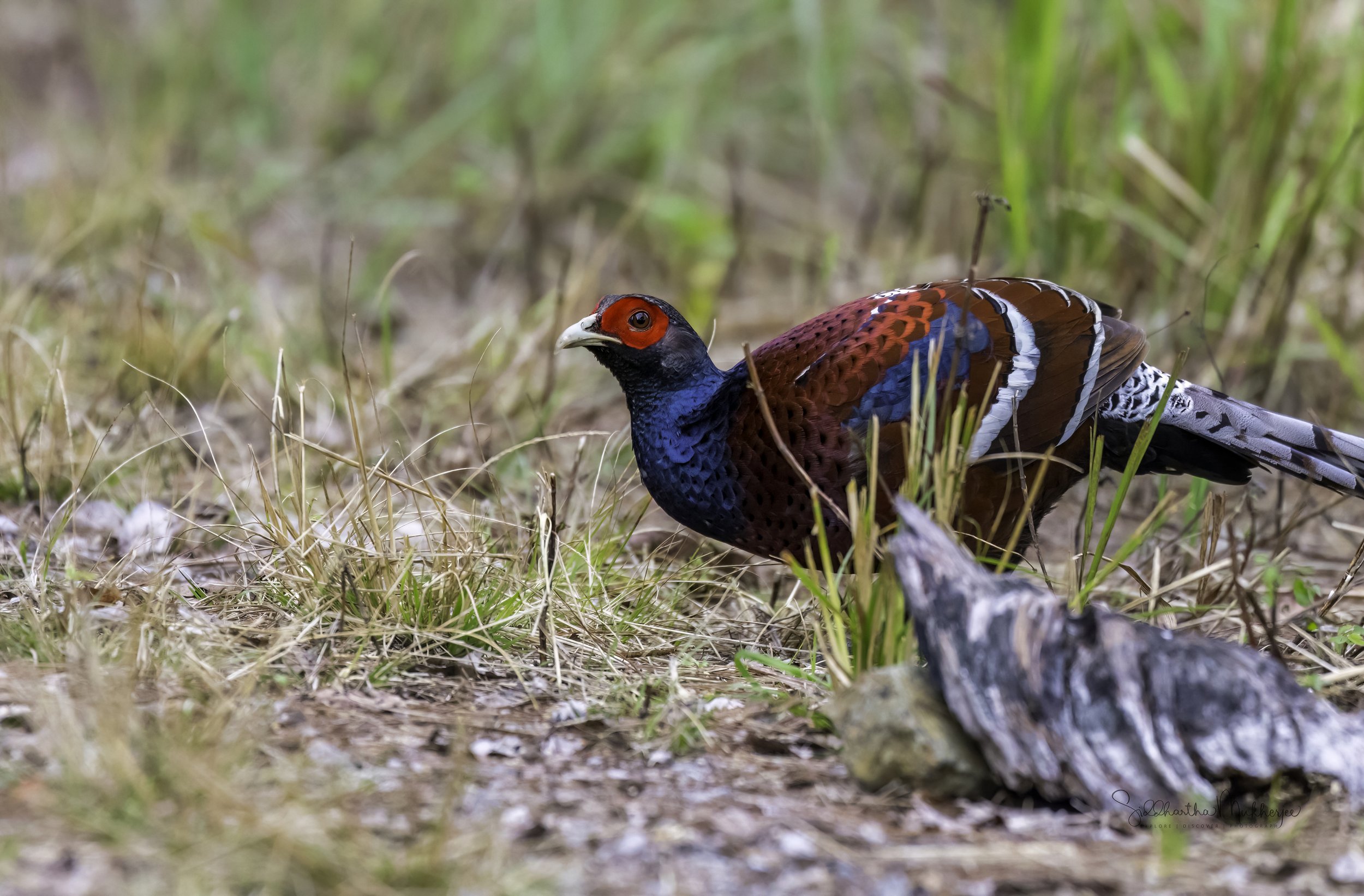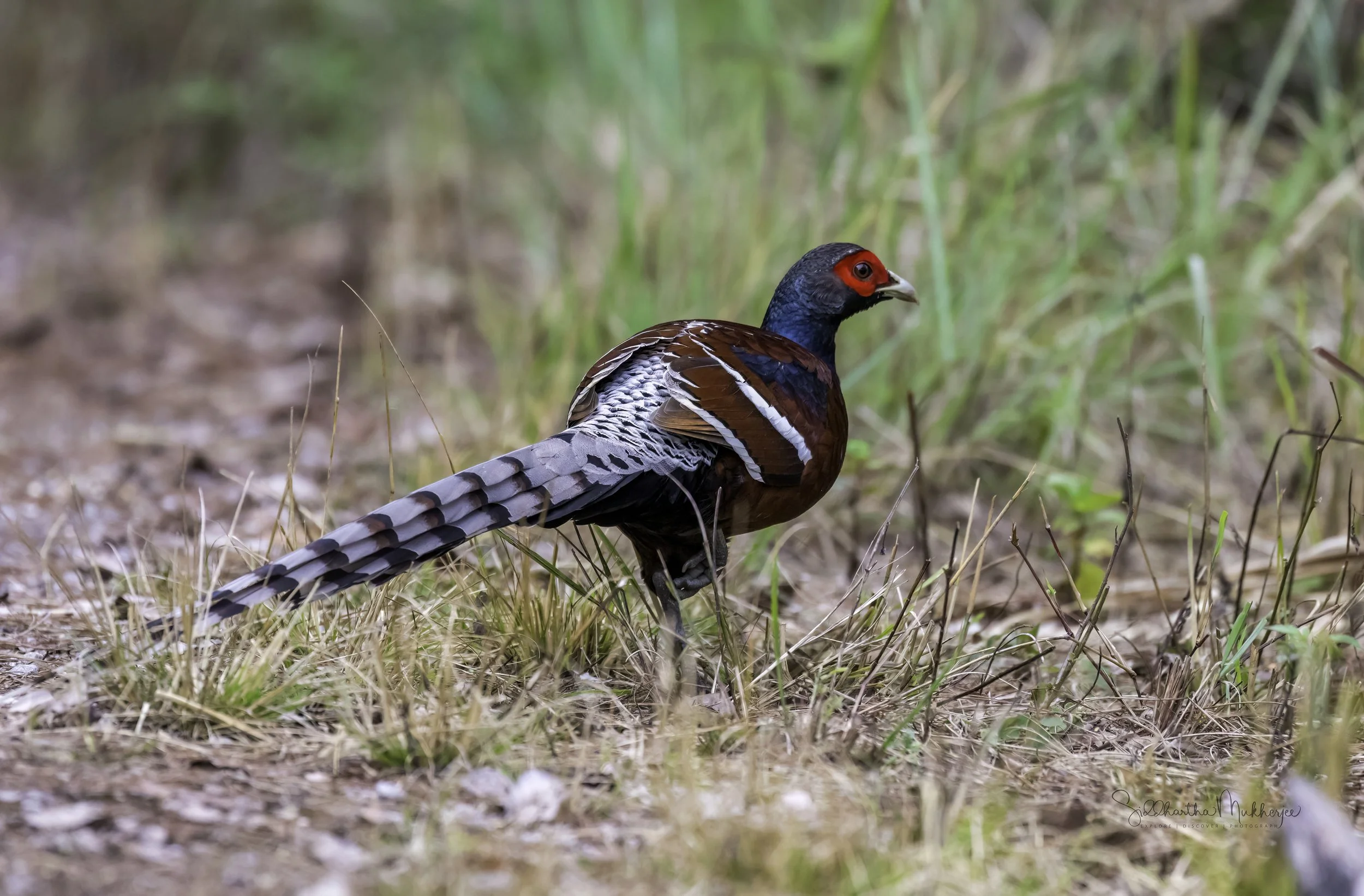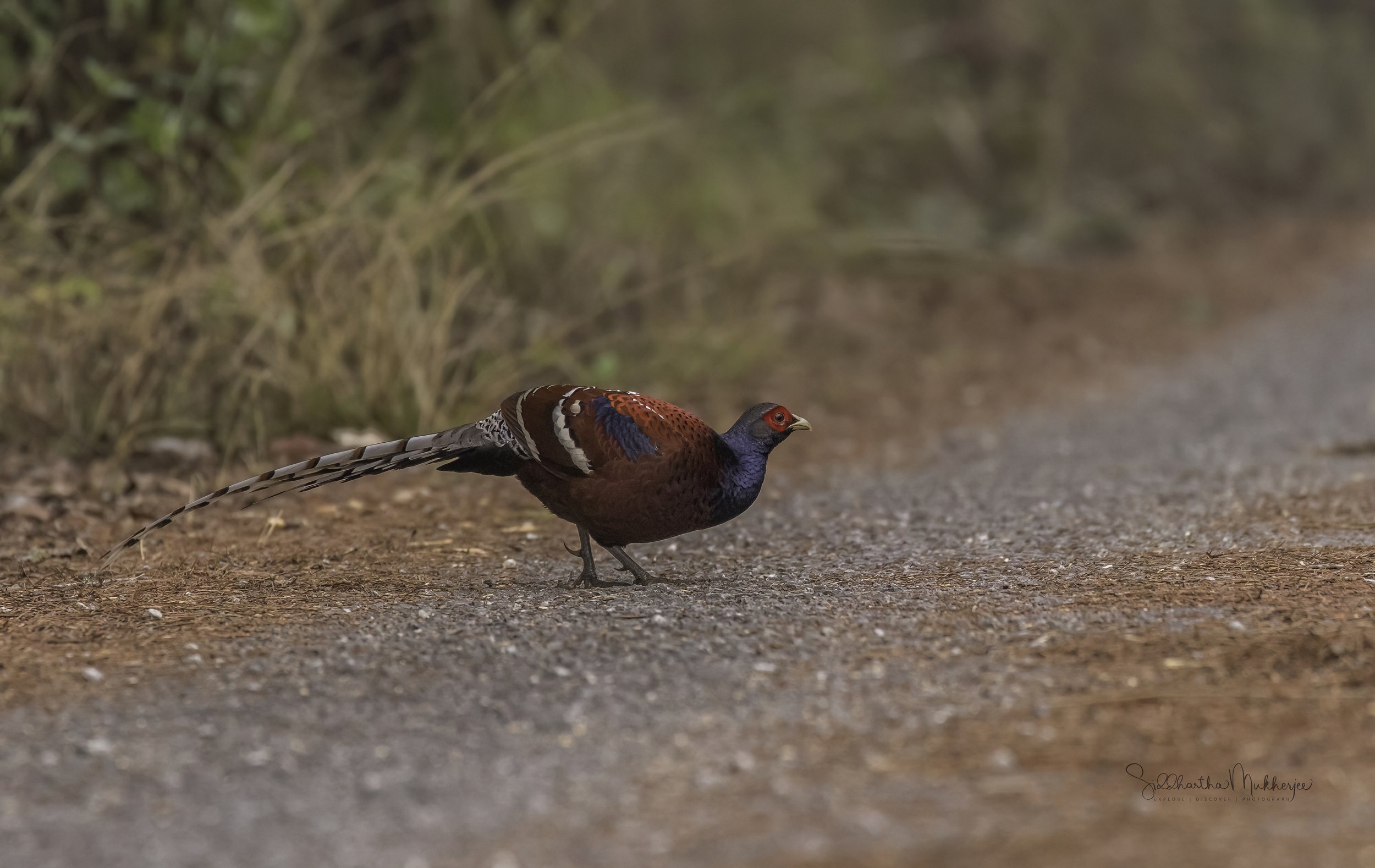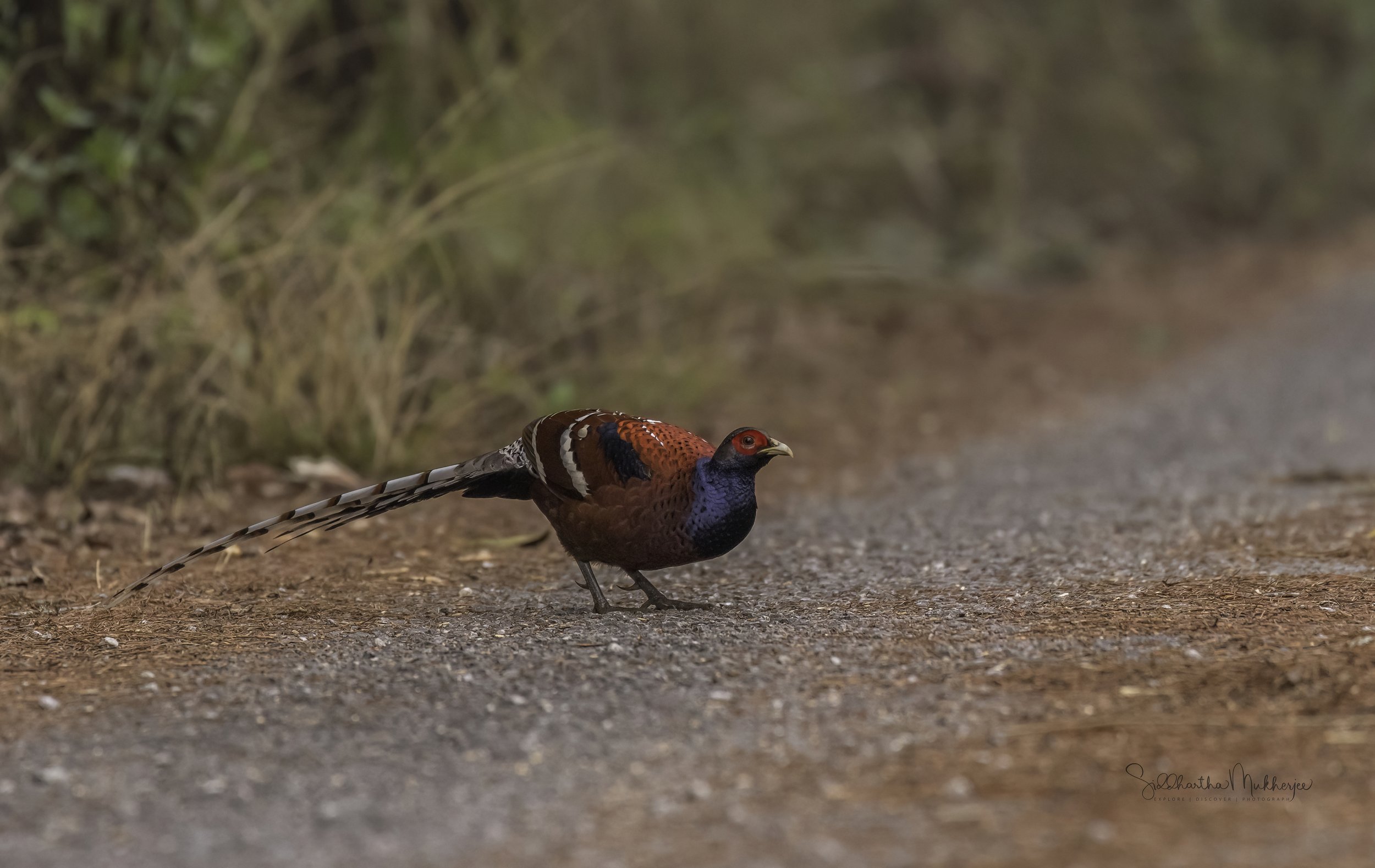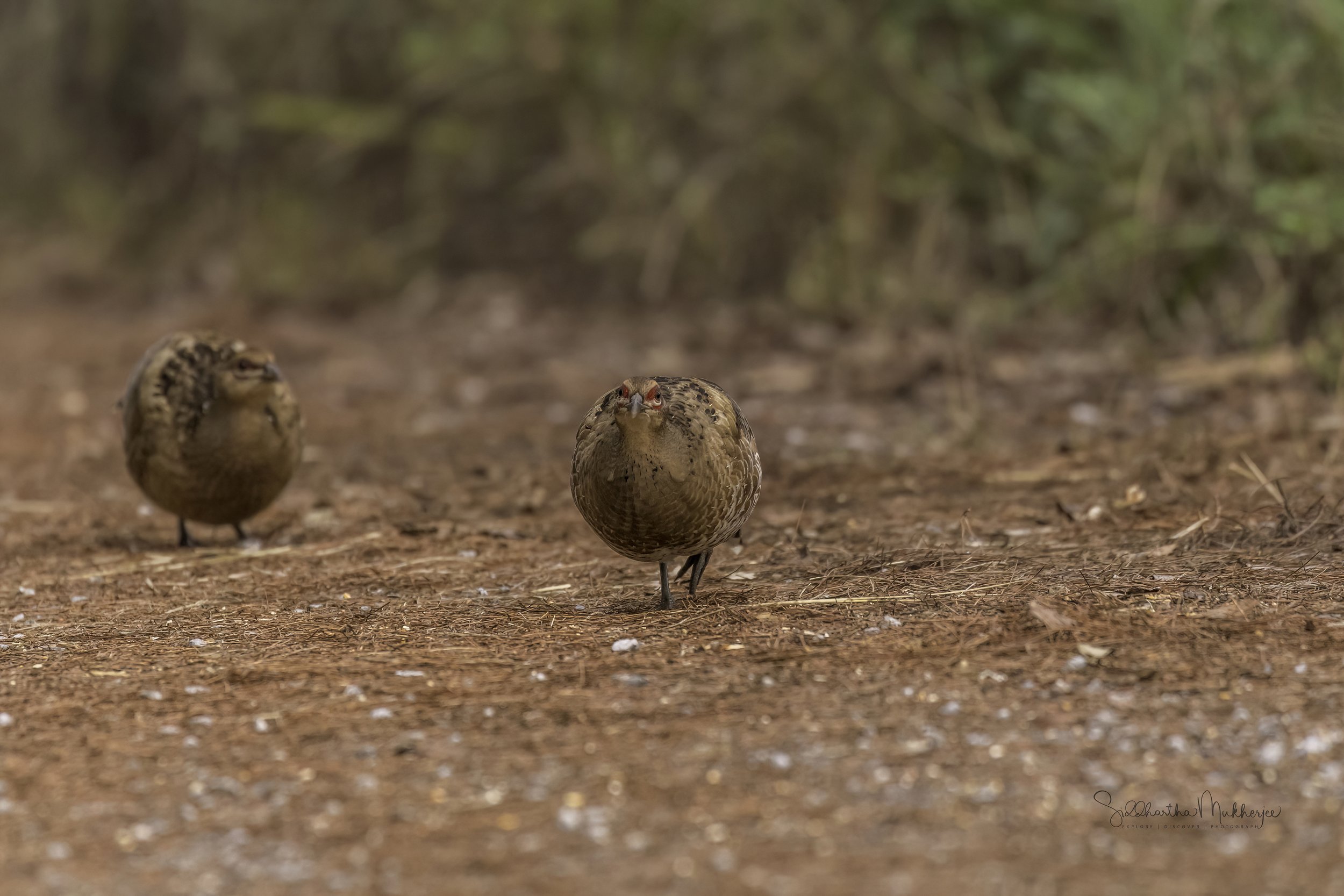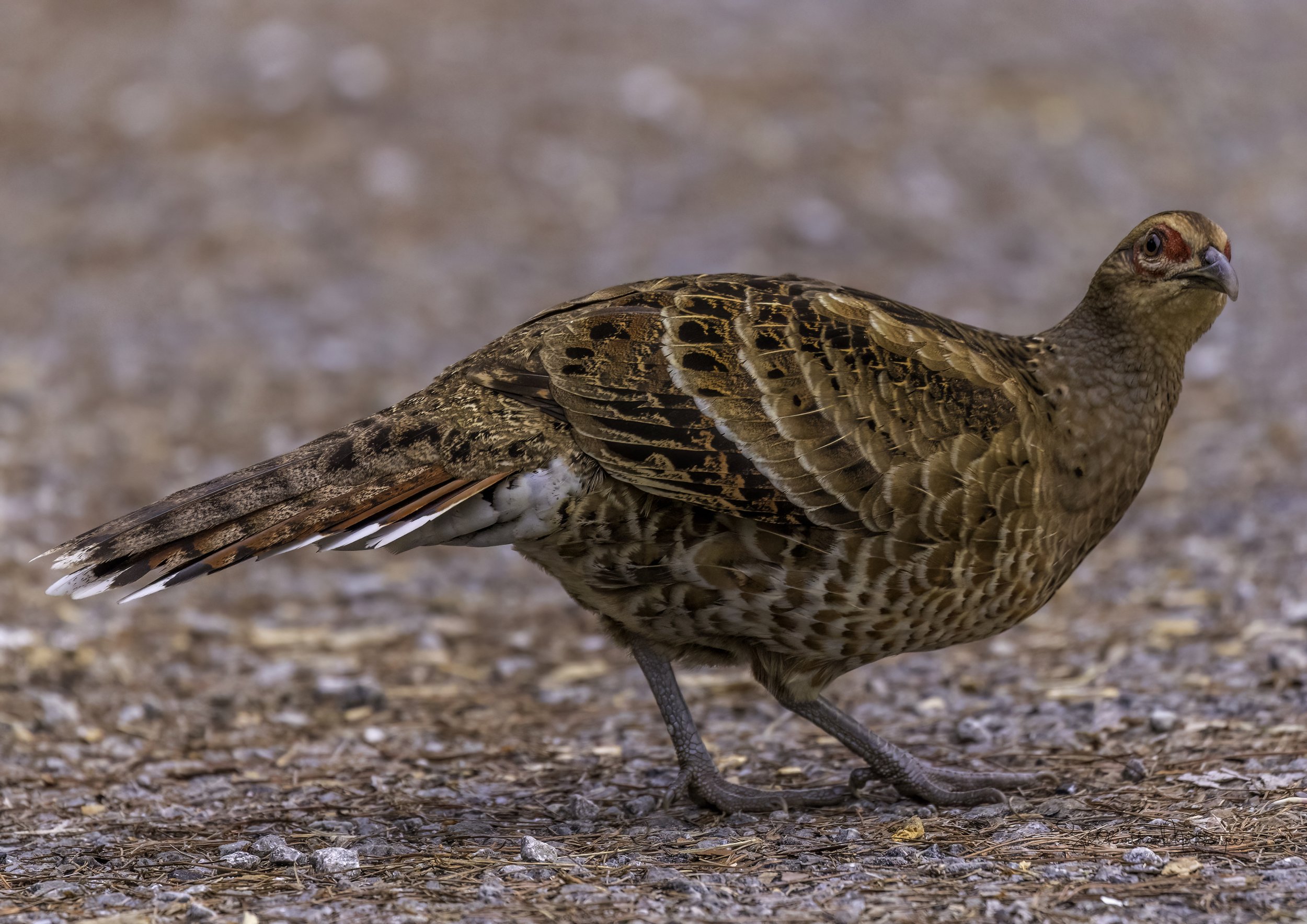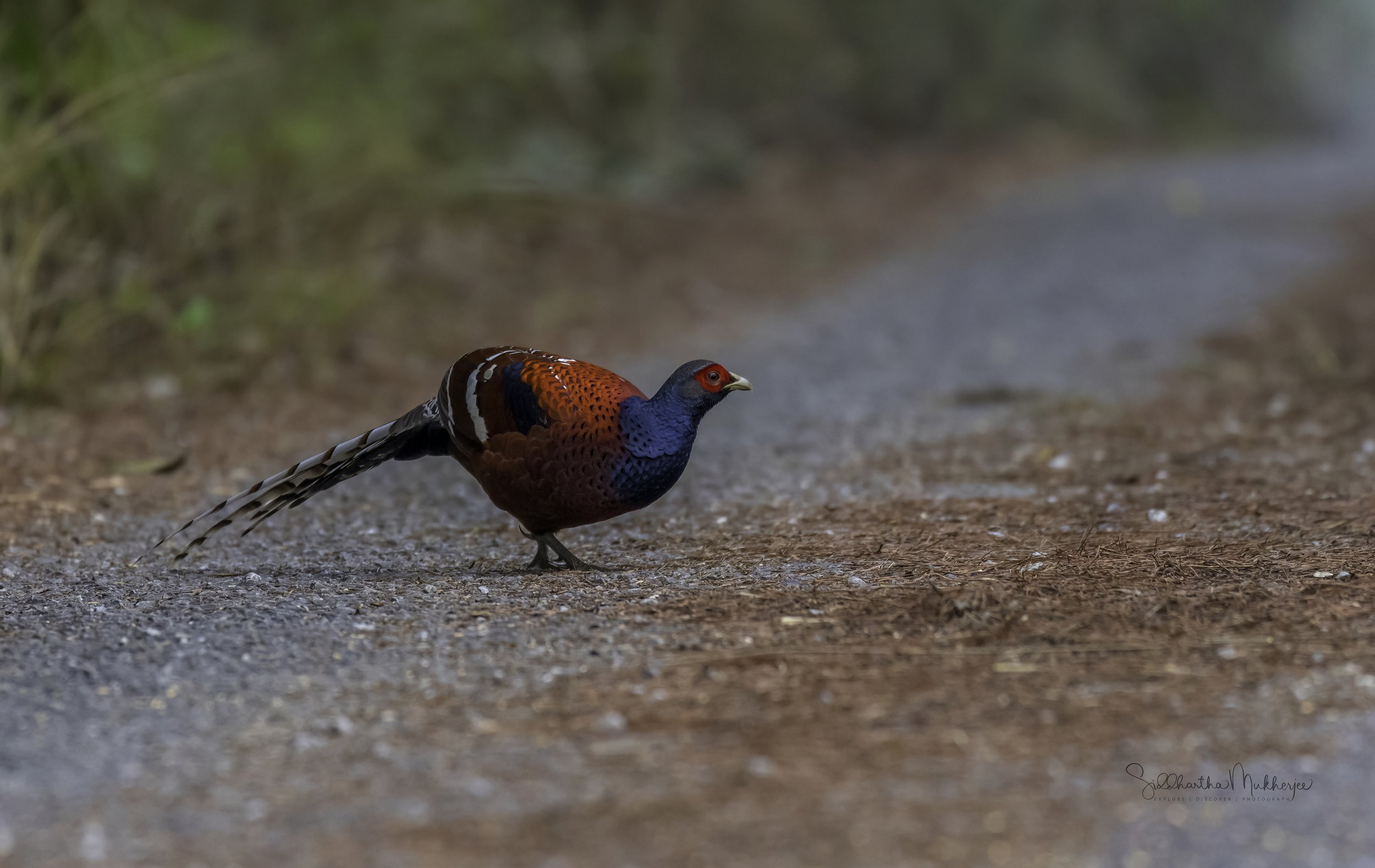Mrs. Hume’s Pheasant
Syrmaticus humiae burmanicus
NEAR THREATENED
Doi Ton Phueng, Chiang Mai, Thailand
State Bird of Manipur, India
The beautiful state of Manipur is a junction of two ecological hotspots and is a place of rich biodiversity. The state is endowed with hills, diverse terrain, rivers, plains, swamps and wetlands. More than 500 species of birds and almost the same number of orchid species have been recorded here. A couple of decades back thousands of parakeet could be seen flying from the south to the north of the state in the morning and returning again in the evening. Unfortunately these spectacular views have almost disappeared now. The mating call of the Hari Nongnag or Cicada males, to attract the perfect mate, which could be heard in these hills of thick vegetation around dusk can no longer be heard. The calls of the Indian Koel and the Crow have also not been heard. Some more birds like the Burmese peafowl (Wahong), hornbills (langmeidong) are also no longer seen. Some varieties of Pelicans and Cranes which migrated to the Loktak Lake have stopped their journey. But all is not lost. Manipur and some of the states of North eastern India are home to Mrs Hume’s Pheasant - a poorly known and globally threatened (Near Threatened) species (BirdLife International 2004). It is thinly distributed in the hill tracts of north-eastern India, north and west Myanmar, south-west China and north Thailand. Very little current information on its status and distribution is available.
The legend of the Nong-In
Mrs. Hume's Pheasant is lovingly called Loining-koi or Noining-koi or Nong-in, in Manipuri or Wa-ru in Lamkang or Tikaren in Tangkhul. The bird is, indeed, iridescent. It usually resides near rivers with rocky hillsides abundant with scrub forests. The people of Manipur believe that the eternal souls of a loving couple, dying from hunger and thirst, transformed themselves into this spectacular pair of birds and came to be known as the Nong-in. In fact, this bird earned its name 'Nong-in' because of its ability of knowing changes in weather conditions or cycles of cloud in the sky (Nong - meaning rain, in - meaning to follow: one knowing the rain/weather cycle). Admired by lyricists and naturalists of all ages, Nong-in is often described as the most talented lover of song, dance and moonlight.
Nongin was declared the State Bird of Manipur in 1989. The name - Mrs. Hume's Pheasant - is in honour of Mrs A.O. Hume, the wife of Allan Octavian Hume., an influential ornithologist from the nineteen century, and it was he who scientifically recorded the bird during his expedition to Manipur in 1881. Allan Octavian Hume was a British political reformer, ornithologist, civil servant and botanist who worked in British India and explored the lesser known state of Manipur recording as many as 500 bird species. Hume came to India as a Civil Service Officer, first to Manipur as a Junior officer leaving as a Collector and transferring to the town of Etawah in 1856. In his fourth expedition to Manipur, in the first half of 1881, he managed to record all the bird species found in Manipur.
However, the ancestor of Mrs. Hume’s pheasant is thought to be the common pheasant (Phasianus colchicus), which is native to Asia and Europe.
But how did all of this come to pass? The first hint of the existence of the Nongin came from some ceremonial feathers, given to an envoy by the Maharaja of Manipur. The royal kings of Manipur had traditionally presented these feathers as awards to hunting heroes and for victories in war. Determined that the bird “had to be got“ Hume started his expedition and at one point his party consisted of 60 to 100 men including officers, sepoys, workers, boatmen and villagers. The men cut through the dense vegetation of these jungles to allow Hume to get a shot at these mysterious birds. Within the week they had returned with a beautiful skin and an uninjured bird in a cage, both males. But just like Jim Corbett did, Hume too, in his later years, eventually abandoned hunting and the collection of bird species. It is estimated that he shot around ten thousand birds in his lifetime under the guise of scientific study. Hume returned to England in 1894 at the age of 65 and died in London in July 1912 at the age of 83.
This backstory of A. O. Hume is based on an article by N. J. Collar & R. P. Prys-Jones (2012) Pioneer of Asian Ornithology, Allan Octavian Hume.
However there was a time in the recent past when this state bird was considered extinct locally. The state zoological garden did not have a single specimen in 1976. But after the state government declared an award of ₹50,000 per pair of live Nongin in 2010, at least 5-6 Nongin were brought by the villagers of Rajak Khullen and Shiroi Village of Ukhrul District.
Another search of the bird was performed by Anwaruddin Choudhury who was the then Deputy Commissioner of Baksa, Assam in January 1996, January 2001, October 2001 and February 2002. According to him the wild distributions of Nongin were in the hills of North-East Manipur in Ukhrul district in the North-East of Senapati district & in the Valley of the Irang River in Tamenglong district and the Karong and Phailenkot in Senapati district.
It was reported that in 2010, Shri Hitler Singh, the Ranger along with Shri Dr. Kh. Shamungou Singh & R.K. Birjit Singh, 2010 visited Razai Khullen in the Jessami Sub-Division of Ukhrul district. The team went into the jungle on foot and spent the night in the jungle, but could not find the bird. The villagers mentioned that the bird was mostly seen in the month of March or early April. A few Nongin have been kept at the Zoological Garden under Captive Breeding Programme. Recently a foundation stone was laid at Shirui village for conservation of a breeding centre for Nongin. The State Government has Shiroy Lily National Park, Yangoupokpi Lokchao Wildlife Sanctuary, Kailam Wild life Sanctuary, Jiri-Makru Wildlife Sanctuary, Bunning Wild life Sanctuary and Zeliad Wildlife Sanctuary to protect and conserve the habitat and maintain a sustainable environment.
In India, the Hume’s Pheasant is mainly found in the states of Arunachal Pradesh and Nagaland. They have also been reported in the neighbouring states of Manipur and Mizoram. Also quite well known are several protected areas in India, which are important for the conservation of the species and its habitat, some of which are:
Singalila National Park - Located in the state of West Bengal, Singalila National Park is a protected area that covers an area of 78.6 square kilometres. The park is known for its high biodiversity and is home to several threatened species, including Mrs. Hume’s pheasant and the equally elusive and endangered Red Panda.
Neora Valley National Park - Located in the state of West Bengal the Neora Valley National Park covers an area of 88 square kilometers. The park is known for its pristine forests and high biodiversity and is home to several endangered species, including Mrs. Hume’s pheasant.
Namdapha National Park - Located in the state of Arunachal Pradesh, Namdapha National Park is one of the largest protected areas in India, covering an area of 1,985 square kilometers. The park is known for its rich biodiversity and is home to several threatened and endangered species, including Mrs. Hume’s pheasant.
Eaglenest Wildlife Sanctuary - Located in the state of Arunachal Pradesh, Eaglenest Wildlife Sanctuary is a protected area that covers an area of 218 square kilometers. The sanctuary is known for its high biodiversity and is home to several threatened species, including Mrs. Hume’s pheasant.
Khangchendzonga National Park - Located in the state of Sikkim, Khangchendzonga National Park is a protected area that covers an area of 849.5 square kilometers. The park is known for its high biodiversity and is home to several threatened species, including Mrs. Hume’s pheasant.
These protected areas play a crucial role in the conservation of Mrs. Hume’s pheasant and its habitat. They provide important breeding and nesting sites for the species and help to protect it from hunting, poaching, and habitat destruction. Additionally, they help to maintain the ecological balance of the region and provide a vital source of ecosystem services to local communities.
The bird is included in the Schedule I of the Wildlife Protection Act, 1972. Wildlife (Protection) Act, 1972 and Rule 1974.
The mountains of Chiang Mai
About 685 kilometers to the north of Bangkok lies the former seat of the ancient Lanna Kingdom and is considered one of the most scenic provinces in the country given its mountain ranges, valleys, flora and fauna. A land of misty mountains and colourful hill tribes, a playground for seasoned travellers, and a delight for adventurers. Despite its relatively small size and blissful calm, Chiang Mai truly has it all, a city that is still firmly Thai in its atmosphere and attitude. It is the second-largest changwat (province) of Thailand. Bordered by Chiang Rai to the northeast, Lampang and Lamphun to the south, Tak to the southwest, Mae Hong Son to the west and the Shan State of Myanmar to the north. Located in a verdant valley on the banks of the Ping River, Chiang Mai was founded in 1296 as the capital of the ancient Lanna Kingdom. Today it is a place where past and the present seamlessly merge with modern buildings standing side by side with venerable temples. Of all the places I have visited in Thailand, Chiang Mai with its forests and mountains and the historic city of Ayutthaya are by far my favourites.
Most famous for its beautiful ancient temples, the historical city of Chiang Mai is quite a diverse place, with different neighbourhoods having very distinct personalities. At its heart is the beautiful Old City. Outside its almost perfectly square moat and ancient city walls is the bustling Night Bazaar, the peaceful Riverside and the modern Nimman Road. The striking mountainous landscape around the city provides a lot of wonderful natural attractions and is home to two tribal villages. We however saw very little of the city itself and spent most of our time in the mountains and forests surrounding the city.
I would like to give my heartfelt thanks to our wonderful guide and host - Atiwich Kwaechum Ball (inset). Affectionately called Ball, he took phenomenal care and ensured that we got the species we targeted. Another crucial aspect he handled with aplomb was the food. Chiang Mai’s dining scene is outstanding with excellent choices, ranging from first-class fine-dining restaurants with international menus to little local joints specialising in the area’s unique and tasty cuisine. The food is especially remarkable, with an emphasis on small shared dishes. With Ball showing the way we had THE best culinary experience ever considering our penchant for staying away from civilization more or less on these trips.
With its more Northern latitude and higher elevation, Chiang Mai enjoys a cooler climate than the stifling central plains near Bangkok. During the hot season, however, the temperature rises quite a bit and perhaps the rising mercury is the reason why Songkran (the water festival) is celebrated so enthusiastically here. Due to the more tropical location of Chiang Mai, the normal seasons of spring, summer, fall and winter don’t apply. Instead, there are three seasons: Hot, Cool and Rainy.
The cool season lasts from early December to February and is the most popular time to visit Chiang Mai, weather-wise. During the day the temperatures max out at a pleasant 30°C (86°F) and drops rapidly after sunset, sometimes to as low as 10°C (50°F). On the upside, rain in the cool season is rare and more than one shower in a month is uncommon. And therefore our trips were in the winter and we spent almost all our time on 4 mountains or Dois. Look up Chiang Mai province in a guide or on a map and you’ll see the same Thai place names cropping up over and over again: Doi this, Mae that and so on. So what do they all mean? The word Chiang itself is from North Thai, or Lanna, meaning town or city and Mai means new making Chiang Mai the New City as it was founded later than Chiang Rai, the earlier capital of King Meng Rai. The districts in the province are called amphoe, and sub-districts are called tambon. Another twist is the use of Nakhon (or Nakorn or Nakhorn), derived from the Sanskrit word Nagara, also means city, though strictly speaking it refers to a capital city such as Nakorn Sri Ayutthaya (more on Ayutthaya later). Indeed to emphasise its former status you may sometimes see Chiang Mai referred to as Nakhon Ping. Other common names of geographical features include mae (river) and doi which is north Thai for mountain - for example Doi Inthanon and Mae Ping.
The four Dois we spent our time on were Doi Inthanon, Doi Ang Khang, Doi Luang and Doi SanJu.
Doi Inthanon is Thailand’s highest mountain is a site of unique biological interest and supports a fascinating variety of vegetation and a higher bird species total than any other protected area. Of the total of 382 species of birds so far known from Doi Inthanon, at least 266 species are residents or were formerly residents on the mountain. Doi Inthanon is of particular conservation importance for those species which inhabit the moist hill evergreen forests of the upper slopes. Some, such as the Chestnut-tailed Minla and White-browed Shortwing, which are around the summit, occur in Thailand only on those few higher mountain summits which have considerable areas of hill evergreen forest above 1800 m. Doi Inthanon contains the only significant protected populations of such species in Thailand. The Ashy-throated Leaf-Warbler is found nowhere else in Thailand while an endemic race of the Green-tailed Sunbird (Aethopyga nipalensis angkanensis) is also completely confined to the summit. The Wachirathan Waterfall is one of the best sites for observing birds of fast-flowing streams. The Plumbeous Redstart and the River Chat often perch on boulders in mid-stream. The Slaty-backed Forktail can sometimes be seen. Among the many scarce arboreal birds to look out for are the Long-tailed Broadbill, Brown-throated Treecreeper, Green Cochoa and Purple Cochoa and Black – tailed Crake.
Doi Ankhang is a mountain belonging to the Himalayan foot hill range, located at the Myanmar (Burmese) border. The highest point is 1,928 metres. Although chiefly deforested, this is still one of Northern Thailand’s most prominent birdwatching areas, due to more and rarer bird species being in residence, as well as being a popular resting point for numerous migratory birds. Examples of rare and beautiful birds inhabiting this area include the Spot-breasted Parrotbill and the Red-faced Liocichla. A highly recommend site to find the rarest bird species is the picturesque area named Heavenly Valley. It is not so uncommon to spot the Red-tailed Laughing Thrush here. Around The Royal Agricultural Project Station you can find Brown, Burmese and Long-tailed Shrike and also Fire-capped Tits and Silver-eared Mesia, White – tailed Robin & Maroon Oriole.
Doi Luang & Doi SanJu in close proximity to the Doi Pha Hom Pok National Park, it is the second highest mountain in Thailand and a part of the Dan Lao Mountain range, northwest of Chiang Mai, sharing the border with Myanmar. Doi SanJu, can be easily accessed from Fang town. The mountain forest and no traffic make it easy to view birds. The entire area is very quiet, secluded and home to rare species like Mrs. Humes Pheasant, Long–tailed Sibia, Himalayan Cutia, Black–throated Tit, Black–eared Shrike Babbler, Whiskered Yuhina, Crimson–breasted Woodpecker, Fire–tailed Sunbird to name a few.
We didn’t have the good fortune to see all the species on all the mountains, that would have been impossible, but we did rack up quite a number of species - about 95 of them. Here are some of them with a sprinkling of the amazing landscapes.
But to see this spectacular near threatened forest pheasant we had to take a little bit of a deviation to Doi Ton Phueng.
Doi Ton Phueng is another mountain located in Chiang Mai with an elevation of 764 metres above MSL. This is still considered a part of the Doi Luang range at an elevation high above the surrounding area with a small summit area, steep slopes and local relief of 300m or more. Doi Ton Phueng is situated near the localities Ban Dong Pa Ko and Ban Mon Wat.
And a very special shout out to my friend Easwar Subramanian for identifying every single bird and pointing me in the right direction every time. Thank you! This massive list would not have been possible without you.
A number of these birds have been published in various blogs by the National Geographic & the Wild Bird Trust and can be seen on my Publications page. Some have been painted in watercolours and can be seen in my Birds as Art Gallery and for some I have detailed blogs. The blogs, where I have them, are linked directly from the photos so click through and enjoy a gallery of the species and how they co-exist with others.
Mrs. Hume’s Pheasant
The state bird of Manipur, Mrs. Hume's Pheasant (Syrmaticus humiae) (Meitei: Nongin; literally, "one who follows the track of rain"), also known as Hume's pheasant, Mrs Hume's Barredback Pheasant or the Bar-tailed Pheasant, is a large (up to 90 cm) dashingly plumaged, long-tailed terrestrial forest pheasant. Closely resembling Elliot's Pheasant , the male of this pheasant species has a grayish brown head, bare red facial skin round its eyes, yellowish bill, brownish orange iris,, glossy steel-blue feathers on its throat, neck and upper breast; deep chestnut-brown plumage on its abdomen and flanks, and three conspicuous white bars on the upper wings. Besides, it has black & chestnut bars all across its long silvery-grey coloured tail. The female is chestnut brown bird with whitish throat, buff-colour belly and white-tipped tail.
This rare and little known pheasant is found throughout forested habitats of the Mizoram, Patkai Range, Manipur, Yunnan and northern parts of Myanmar and Thailand. The Hume's Pheasant is endemic in the regions of northeastern India, Myanmar, Thailand and China. Two subspecies are named from these places; one is Syrmaticus humiae humiae in the hills of Manipur, Mizoram through western Myanmar south to the river Irrawaddy, while the other, Syrmaticus humiae burmanicus, featured here, finds its habitat in the forests of south western China, northern and eastern Myanmar and extreme northern part of Thailand.
Mrs. Hume’s pheasants are primarily ground-dwelling birds, though they can fly short distances if needed. During the breeding season, males display their iridescent plumage & perform elaborate courtship displays to attract females. Females lay 4-8 eggs in a nest on the ground and are responsible for incubating them & raising the chicks. The offspring of Mrs. Hume’s pheasants are born after an incubation period of about 28 days. Chicks are able to leave the nest shortly after hatching and are able to fly at around 10-12 days old. They reach sexual maturity at around 2 years old.
The population of Mrs. Hume’s pheasant in India is estimated to be very small, with the exact number of individuals remaining uncertain due to limited surveys and data. However, it is believed that the species is declining in numbers due to habitat loss, hunting, and other human activities that affect its survival. Although, the exact population - size and status - remain virtually unknown, today, the Hume’s pheasant in Manipur appears very rare and vanishing. Its past range covers Ukhrul, Valley of the Barak River and its tributaries, the mouth of Thoubal River etc between 900-1800 metres. Here the bird was frequently seen along the open dry evergreen, mixed pine-broadleaf forests on the steep rocky hillsides, interrupted by scrub and grassy plains. Roosts were mainly located along ridges, and in other relatively open areas. They often spend time feeding and resting in pairs, rejoicing in mud-bathing or sunbathing for hours together or till eventide. When a sudden danger or change of weather was sensed, the frenzied birds crawled behind the rock-clefts with noisy calls. When a pair from a cleft-shelter started calling, another pair nearby responded, and within a short period the entire ambience is filled with a chorus of their calls. Trawlers took advantage of this behaviour to located the bird.
Source: By Donkey shot - Own work, CC BY-SA 3.0, Wikimedia Commons
In October 2005, a 60-70 year old Tamenglongian revealed his past experiences of Nong-in, locally known as Azuina/Thangding in Rongmei (these names are not certain) in small flocks mostly one male with three-four females near brooks with rocky hillsides and plenty of sand deposits along the course. They came out mostly during the early mornings and after feeding through the morning, they perch and rest. Frequently a bird lays one wing over the other wing with the legs stretching out in one direction, which may be a form of complete rest in a tranquil environment.
Mrs. Hume’s pheasant is listed as a Vulnerable species by the International Union for Conservation of Nature (IUCN). It was first assessed as Vulnerable in 1994 and has remained on the Red List since then. It is considered vulnerable due to several threats that are impacting its population and habitat. The species’ habitat is being lost and degraded due to deforestation, agricultural expansion, infrastructure development, and human settlements. This is leading to the fragmentation of its habitat and the loss of important food and nesting resources.
Mrs. Hume’s pheasant is also hunted and poached for its meat, feathers, and as a trophy bird. Hunting and poaching have been identified as significant threats to the species in some parts of its range. The introduction of non-native pheasant species to the region can lead to hybridization and inbreeding with Mrs. Hume’s pheasant, which can result in the loss of genetic diversity and a decline in the species’ fitness. Changes in climate and weather patterns have also affected the species’ habitat and food resources, leading to changes in its distribution and abundance.
Overall, the conservation status of Mrs. Hume’s pheasant remains a concern, and efforts are needed to protect and conserve the species and its habitat. Conservation measures such as habitat protection, law enforcement against hunting and poaching, and community-based conservation initiatives can help to address the threats facing the species and improve its conservation status.
In the recent past, habitat modification and overexploitation in the form of deforestation and extension of developmental programmes are the main causes for complete decimation of these birds in the wild. In Manipur the bird's habitat has been destroyed and severely fragmented by extensive shifting cultivation and uncontrolled annual forest fires. A more direct threat is posed by poaching and snaring of this bird which has continued unabated for years more so as the range of the species overlaps with that of the hill tribes, and in spite of having several preventive laws and regulations, their hunting lifestyles are still prevalent. The fact that the Hume’s pheasant is endemic to Manipur and that it has attained an emblematic status representing the state is not common knowledge. A highly adhesive gum prepared from certain locally available herbs is often used for capturing the bird. Such preparations may be left on the ground or smeared on logs near the watering holes the bird frequents. As a result of this unfortunate practice, not only the Nong-in, but the other pheasants of the state have become endangered too. Though, fortunately, no pheasant species has as yet disappeared from the state, the continuing pressures and their peculiar habitat - critical to their survival - will eventually prove to be fatal, if these practices continue unabated.
‡‡‡‡‡
Video Gallery
Related Posts



